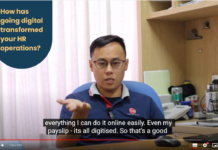We can’t deny that technology has completely changed the way we live and work. Over the years we have seen a proliferation of Digital Platforms with the likes of Uber, Taobao, AirBnB, remodeling the landscape at which consumers and producers interact. No longer are we required to physically flag a cab, or make our way down to a store just to find what we are looking for(and perhaps end up being disappointed instead). Everything we need these days is right there at our fingertips and all we have to do is simply tap a couple of times on our mobile devices to get what we want.
With that in mind, traditional companies are being aggressively pushed to shift towards digitizing their business, be it in their operations or enhancing customer experience, just so they can keep up with the fast changing demands and expectations. Ideally this can be done without compromising the workforce, but the harsh reality is that most new technologies end up directly replacing the existing human resource to complete designated jobs.
An example would be the role of a supermarket cashier. In our increasingly Self-Service world, we see more supermarkets around us implementing self-checkout kiosks for customers to perform checkout and make payment of their grocery purchases themselves. Not only does this free up the need for businesses to frequently hire cashiers where turnover is high, but also enables customers to transact conveniently at their own time.
Nonetheless, technology cannot stand on its own. Consumers today still expect great, personable customer service and that’s not quite something technology itself can readily offer as of right now. In the case of self service checkout in supermarkets, manpower assistance will still be required to oversee the usage of such self-service kiosks and assist customers whenever necessary.
Here’s a few tips from us on how best you can transition your business into one that incorporates a partnership between existing human resource and relevant new technologies:
Research what’s out there
It’s about time to get out of your own bubble and keep a lookout on what’s happening in your industry. Is there a digital shift? Are your competitors investing in new technologies that customers are positively reacting to? Maybe there are business functions slacking in productivity? Focus on the key areas that technology is disrupting your industry, be it in customer service, operations or product enhancements. By placing priorities on what’s truly important in transition, your business will be able to get started on the right foot and advance much more effectively.
Assess your Resources
So now you’ve figured out what your business needs are, and perhaps it’s a drastic change that you think calls for drastic measures. Well transitioning to the digital world does not necessarily mean for businesses to completely replace what they already have. Examine your business to find out which of your resources will keep their value, which ones will not and which ones you may be able to use in new and improved ways.
Identify Change Agents
Your business can’t undergo digital transformation or adopt new technologies if your people are resistant to change. Having designated Change agents who are well aligned with the business’ vision and road map will alleviate some of the confusion and uncertainty among employees, while providing feedback to management of challenges faced by employees at the same time. Change Agents are people in your business who communicate effectively and have the ability to drive change. Although technically anyone can be a Change Agent, start off with Department Heads or Team Leaders who have the best ‘on the ground’ knowledge through frequent interactions with the people they work closely with.
Upskill your people
With potential new technological integrations in your business, you need people who not only know how to use it, but also fully understand its capabilities. It’s undeniable that the younger generation are generally more adept when it comes to new age technology, however it doesn’t mean the older workforce no longer has any relevance in the digital age. Armed with a wealth of experience, our older generation are equipped with valuable wisdom and strong work ethics. Engaging in Reverse Mentoring is a relatively cost effective way that may enable businesses to retain its most valuable human resource and foster an empowered workforce that embraces change together.
We live in a world where different generations all expect and value vastly different experiences in life and at work. Though businesses may thrive today through traditional methods to cater to the generations that value what they can offer, it is hardly a sustainable model for the ideal long run. If businesses don’t budge out of their comfort zones, they may lose out to those who do.
 Home
Home















